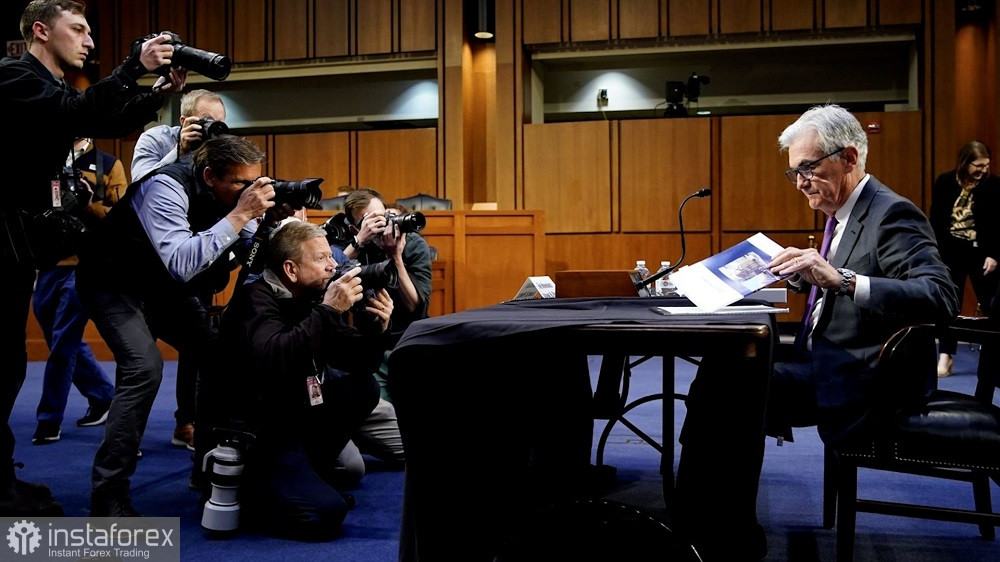U.S. Federal Reserve Chairman Jerome Powell provided significant support to the U.S. currency. Speaking yesterday in the U.S. Congress, he said that the Fed is ready to accelerate the pace of interest rate hikes "if necessary." At the same time, he suggested that the final level of the rate would be higher than previously thought. Against the backdrop of such rhetoric, the greenback strengthened its position throughout the market, and the EUR/USD pair consolidated within the 5th figure.
Hawks spread their wings
On the eve of Powell's highly anticipated speech (the last time he took a public stance was in early February), most currency strategists warned their clients that the Fed chairman would sound hawkish rhetoric in reaction to the latest inflation releases. The rate of decline in inflation in the United States has clearly slowed, and Powell could not ignore that fact a priori. Therefore, in the run-up to his speech, hawkish expectations were rising, and in my opinion, were somewhat exaggerated. This situation posed a hypothetical threat to dollar bulls because if the rhetoric of the head of the central bank had been "finalizing" despite inflationary trends, the greenback would have collapsed across the market.

But to the surprise of many analysts, Powell, who is diplomatic and usually cautious in his remarks, "overdid the plan" by implementing the maximum program. Most experts assumed he would only announce that the final rate level would be revised upward. In general, this fact has already been won back earlier, following relevant statements by some of Powell's colleagues (notably John Williams, head of the New York Fed). Therefore, if Powell had limited himself to this message, the dollar would have continued to drift in its previous positions. However, Powell went further, allowing a more aggressive rate hike. Such turn of the story cheered up the markets.
It is noteworthy that until yesterday, only some representatives of the Fed (Bullard and Mester, who do not have the right to vote this year) cautiously stated the need to accelerate the pace of rate hikes. According to them, the implementation of the 50-point scenario "would be appropriate at the February meeting." Whereas Jerome Powell, a month ago, not only did not allow such a scenario, but also pointed to disinflationary processes that were then recorded in some sectors of the American economy.
It is clear that the situation has changed drastically in the last four weeks. Inflation has reared its head again, key inflation reports (CPI, Producer Price Index, PCE core index) came out in the green zone, and non-farm payrolls reflected a half-million gain in employment. That is, de facto in February, all conditions were created for strengthening the hawkish mood on the part of the Fed. The head of the Fed only confirmed the central bank's readiness for more aggressive actions but, at the same time, strengthened his words with an additional "option," which involves accelerating the rate hike.
Hawkish expectations are rising
According to the CME FedWatch Tool, there is now a 72% chance of a 50-point rate hike following the March meeting. Whereas the probability of the implementation of the 25-point scenario is 28%. Note that before Powell's speech yesterday, the forecasts were of a mirror nature (the probability of a 25-point increase in the rate was 75%).

Hawkish expectations also intensified regarding further prospects for tightening the monetary policy. For example, the probability of raising the rate to 6.0% at the end of the June meeting is already 16% (before the speech of the head of the Fed, the chances were estimated at a minimum, at 2%). While the probability of increasing the rate to 5.75% in June is almost 58%. I think additional comments are unnecessary here.
Conclusions
Jerome Powell in Congress laid the groundwork for strengthening the U.S. currency. He said that the final level of the interest rate is likely to be higher than previously thought, and also spoke about the possible need to raise the rate more sharply. These hawkish signals will provide background support to the greenback for a long time, especially if key macroeconomic indicators (inflation, labor market) go into the "green zone."
By the way, the U.S. non-farm payrolls will be released on Friday, which could be crucial for deciding on tighter measures—at least in the context of the Fed's March meeting. According to preliminary forecasts, unemployment in the U.S. should remain at the January level, i.e., 3.4%. Meanwhile, non-farm payrolls should show a more modest result than the previous month. In the context of Powell's speech yesterday, another component of the release—the wage component—is key. The wage index is projected to resume its growth (4.7% in February after the January decline to 4.4%). In this case, the trend itself will be important, in light of accelerating inflation in the U.S.
In general, the existing fundamental background for the EUR/USD pair contributes to the development of the downward trend. It is advisable to consider short positions after the price breaks the nearest support level at 1.0520, which corresponds to the lower line of the Bollinger Bands indicator on the daily chart. In this case, the next targets of the downward trend will be 1.0450 and 1.0400 (the lower boundary of the Kumo cloud on the weekly chart).





















